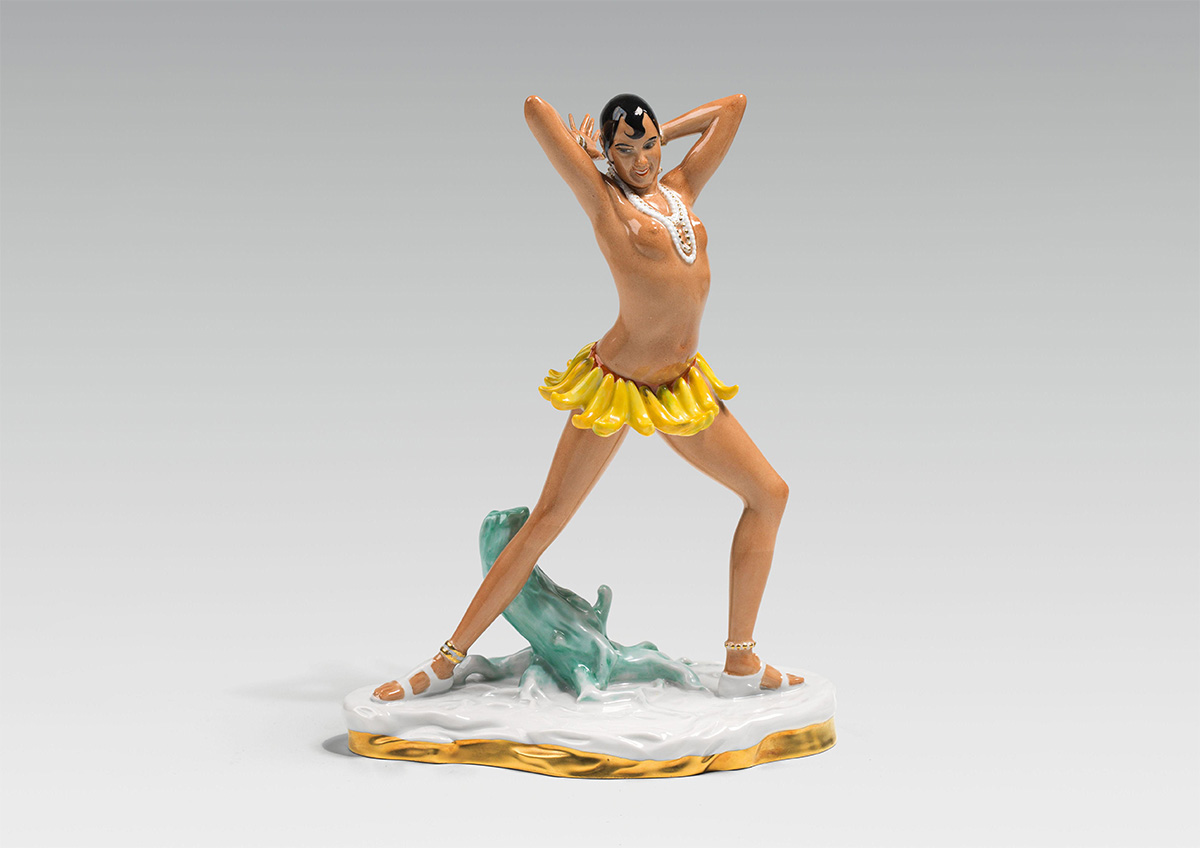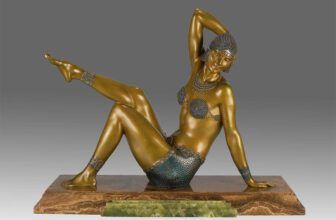
Dorothea Charol Most Famous Art Deco Sculptures
In the shimmering world of Art Deco, a world defined by luxury, geometry, and sleek modernity, few sculptors captured the spirit of the age with as much flair and finesse as Dorothea Charol. Known for her elongated female figures, theatrical poses, and expressionistic detail, Charol’s sculptures have become synonymous with the glamour and sophistication of early 20th-century decorative arts. Her work tells not only a story of artistic innovation but also of survival, reinvention, and an unyielding pursuit of beauty.
The Woman Behind the Elegance: Dorothea Charol’s Life and Artistic Identity
Born in Rostov-on-Don, Russia in 1889, Dorothea Charol’s early years were shaped by the tumultuous changes in Eastern Europe. Of German-Russian descent, she fled the Bolshevik Revolution in the 1920s, eventually finding refuge and artistic opportunity in Germany, a country ripe with avant-garde movements and the burgeoning Art Deco style. She eventually settled in Berlin, a hotbed for creative energy between the wars.
Charol wasn’t just a sculptor; she was a stylist, a visionary, and a woman who brought her unique cultural influences into a form that could only have existed at the crossroads of tradition and modernity. She lived through empires collapsing and ideologies clashing, yet she maintained a distinctive elegance in her work, elegance that continues to captivate collectors and museums alike.
What Is Dorothea Charol Known For?
Dorothea Charol is best known for her Art Deco-style porcelain and bronze sculptures that often depict graceful, elongated women in theatrical poses. Her figures are adorned in luxurious, stylized clothing, often with exaggerated features and bold gestures.
She frequently collaborated with porcelain manufacturers, especially the Rosenthal porcelain factory in Germany, which allowed her to transform her clay models into delicate, detailed figures for a wider market. These sculptures were often small enough for tabletops but monumental in presence.
The hallmarks of Charol’s style include:
Elongated limbs and bodies: creating an exaggerated sense of grace
Geometric lines and patterns: reflecting the boldness of Art Deco
Dramatic expressions and gestures: giving life and motion to static form
Intricate costume detailing: drawing from Russian, Orientalist, and modernist themes
Use of polychrome porcelain and bronze: blending fragility with permanence
Most Famous Art Deco Sculptures by Dorothea Charol
Some of her most iconic pieces remain highly sought after. Here are a few that exemplify her mastery:
1. “Danseuse” (The Dancer)
Perhaps her most famous sculpture, this piece features a tall, willowy female dancer mid-motion. Her limbs are exaggerated, her posture confident and dynamic. The folds of her costume, often highlighted in polychrome glaze or bronze patina, swirl with movement.
2. “Pierrot and Columbine”
A romantic interpretation of commedia dell’arte characters, this duet sculpture reflects both the whimsy and melancholy typical of early 20th-century performance art. It’s a nod to theatricality, a recurring theme in Charol’s oeuvre.
3. “Femme à l’éventail” (Woman with a Fan)
Here, Charol explores themes of elegance and seduction. The fan obscures part of the woman’s face, suggesting mystery, while the costume’s detailing displays Charol’s love for Orientalist and Art Nouveau motifs, reinterpreted through an Art Deco lens.
4. “Standing Lady in Oriental Dress”
This sculpture reflects Charol’s interest in the East and exoticism, popular themes during the Art Deco period. The figure’s robes, headwear, and makeup mimic Kabuki or imperial Chinese styles, stylized through modern European taste.
5. “The Contortionist”
This rare and dynamic figure showcases an athletic female in a daring pose that balances strength and flexibility. It’s an example of Charol’s daring compositions and her capacity to fuse motion with sculptural harmony.
How Did Dorothea Charol Make Her Art Deco Sculptures?
Dorothea Charol was trained as a ceramicist and sculptor, with an academic foundation in traditional techniques. However, her real breakthrough came through her collaborations with German porcelain manufacturers, most notably Rosenthal, where she found both a platform and a production method for her artistic vision.
The Process Behind Her Work:
Sketches and Maquettes
Like many sculptors, Charol began with drawings and small models (maquettes) made of clay or wax. These allowed her to experiment with posture, detail, and proportion.Modeling
She would then sculpt a full version using clay, capturing every curve, fold, and gesture meticulously. The modeling process required exceptional control and artistic instinct, especially given the complex postures and draped clothing her subjects wore.Casting and Firing
For porcelain pieces, a mold was created from the original clay model. This was filled with porcelain slip (liquid clay), which would be fired at high temperatures. For bronze works, the lost-wax casting method was often employed, a technique dating back to ancient times but refined during the Art Deco era.Finishing and Painting
Many of Charol’s works were polychromed, that is, painted in various colors, often with gilding or enamel highlights. This allowed for greater realism and stylization. In bronze versions, patinas were applied for luster and protection.Collaboration with Artisans
Given the complexity of her work, Charol often worked closely with skilled artisans at Rosenthal and other foundries. These craftsmen helped ensure the translation of her original designs into stunning final products, often in limited editions.
How Much Are Dorothea Charol Sculptures Worth?
Dorothea Charol’s sculptures are highly collectible and command significant prices on the art market. Because many were limited editions and have survived in small numbers, they are both rare and valuable.
Current Valuation:
Smaller porcelain figures:
Prices range from $5,000 to $15,000 USD, depending on condition, provenance, and rarity.Larger bronze sculptures:
These can fetch $20,000 to $75,000 USD or more, particularly if they are one-of-a-kind or part of a limited series.Record auction sales:
One of Charol’s more intricate bronze sculptures reportedly sold at auction for over $100,000 USD, setting a benchmark for future sales.
Collectors value not just the aesthetics of Charol’s work, but also the historical resonance of her pieces, representing a bygone era of cosmopolitan glamour and stylistic daring.
Where Can You See Dorothea Charol Sculptures Today?
Although Charol never reached the mainstream fame of artists like Tamara de Lempicka or Erté, her sculptures are prized possessions in private collections, museums, and design-focused institutions.
Public and Museum Collections:
Museum of Decorative Arts (Berlin)
Holds a few of Charol’s works in their permanent collection, showcasing her influence on Weimar-era design.The Porzellanikon (Selb, Germany)
Germany’s national porcelain museum includes pieces from Rosenthal’s Art Deco period, with several sculptures attributed to Charol.The Wolfsonian Museum (Miami, Florida)
Focused on design and propaganda from 1885–1945, this museum occasionally features Charol’s works in Art Deco exhibitions.Private Art Deco Collections in Europe and the U.S.
Major private collectors often lend Charol’s pieces to international Art Deco retrospectives. Many of her sculptures appear in Sotheby’s, Christie’s, and Bonhams auctions.Online Art Galleries and Auction Houses
Specialist dealers in Art Deco sculpture often carry Charol’s works. Occasionally, authenticated pieces appear on platforms like 1stDibs, Artnet, or The Saleroom.
Dorothea Charol and the Soul of Art Deco Sculpture
While the names of male sculptors and painters often dominate 20th-century art history, Dorothea Charol represents a wave of female artists who shaped modern aesthetics behind the scenes. Her Art Deco sculptures are more than decorative objects, they are reflections of a dynamic era when art, fashion, and politics collided.
Her figures carry the bold geometry of cubism, the delicate surface of porcelain, the theatricality of cabaret, and the soul of a displaced artist longing for grace amidst chaos. They are at once time capsules and timeless.
In an age when handmade art often gives way to digital design, Charol’s work reminds us of the value of touch, the curve of a finger, the crease in a skirt, the arch of a spine, carved into permanence with passion and precision.
Dorothea Charol may not be a household name to all, but in the world of Art Deco sculpture, she is an icon. Her work stands at the intersection of elegance and emotion, stylization and strength. Whether displayed on a collector’s mantle or behind glass in a museum, her sculptures continue to turn heads nearly a century after they were created.
As demand for Art Deco masterpieces grows and scholars turn their attention to overlooked women in the arts, Charol’s legacy is only becoming more radiant. Her artistry speaks of a time past but also whispers of timeless truths, of beauty, movement, and the enduring power of form. image/ invaluable




